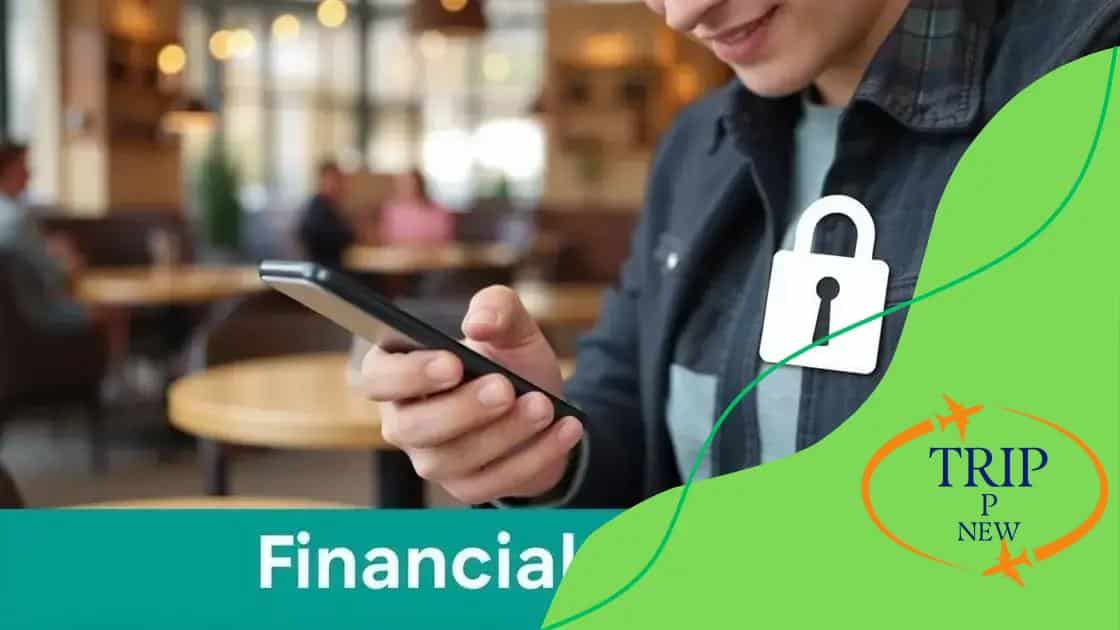Digital wallet security best practices to protect your money

Anúncios
To protect your digital wallet, use strong passwords, enable two-factor authentication, regularly monitor transactions for suspicious activities, and report any unauthorized access immediately.
Digital wallet security best practices are more crucial than ever in our fast-paced digital world. Have you ever wondered how secure your online transactions really are? Let’s dive into effective strategies that keep your finances safe.
Anúncios
Understanding digital wallets and their risks
Understanding digital wallets is essential in today’s tech-driven world. These wallets offer convenience for online payments, but they also expose users to risks. By familiarizing yourself with how they work and the potential dangers, you can protect your financial information.
What are digital wallets?
A digital wallet is a virtual system that stores payment information. Users can make transactions from their smartphones or computers without needing physical cash. This technology streamlines the payment process, making it faster and more efficient. However, it’s crucial to understand the vulnerabilities associated with these wallets.
Common risks associated with digital wallets
There are several risks to consider when using digital wallets:
Anúncios
- Data breaches can expose sensitive information.
- Phishing attacks targeting wallet credentials.
- Fraudulent transactions may occur if wallets are not secured.
- Losing access to your wallet due to forgotten passwords or theft.
Each of these threats highlights the importance of taking necessary precautions. Simply using a digital wallet doesn’t ensure your money is safe. Users need to implement protective measures to mitigate these risks.
How to defend against these risks
Users can enhance their security by following specific strategies. Regularly updating passwords, using two-factor authentication, and monitoring transaction history are crucial steps. Furthermore, educating oneself about common fraud tactics will help in recognizing potential threats.
Overall, being proactive in understanding your digital wallet and the risks associated with it can empower you to make safer financial choices.
Essential security features for digital wallets
When it comes to using a digital wallet, ensuring its security is paramount. Various features contribute to the safety of your financial transactions. Understanding these essential features helps you make informed decisions to protect your money.
Two-factor authentication (2FA)
Two-factor authentication adds an extra layer of protection. With 2FA enabled, you need to verify your identity in two ways. This can involve a password and a code sent to your phone. By requiring two forms of identification, it becomes significantly harder for attackers to access your wallet.
Encryption
Encryption protects your data by converting it into code that can only be decoded with a key. This means that even if someone intercepts your information, they won’t be able to use it without the proper key. Always choose wallets that employ robust encryption methods.
Fraud detection tools
Many wallets now come equipped with fraud detection tools. These tools monitor transactions for unusual activity. If they detect something suspicious, they can quickly alert you. This proactive approach can save you from potential losses.
- Real-time alerts for suspicious activities.
- Transaction limits to control spending.
- Geolocation tracking to verify transactions.
Combining these features ensures a more secure experience. Selecting a digital wallet that showcases these security elements can make a significant difference. Always prioritize security when choosing a wallet for your financial transactions.
Best practices for protecting your digital wallet

Protecting your digital wallet is crucial to keeping your financial information safe. There are several practices you can adopt to ensure your wallet remains secure from potential threats. By following these guidelines, you can significantly reduce your risk of fraud.
Use strong passwords
One of the most effective ways to shield your digital wallet is by using strong, unique passwords. A password that contains a mix of letters, numbers, and symbols is harder to guess. Avoid using easily accessible information, like birthdays or names, as this can make your wallet susceptible to attacks.
Enable two-factor authentication
Two-factor authentication (2FA) is a crucial security measure. It requires a second form of verification beyond just your password. This could be a code sent to your phone or an app that generates a unique code. Enabling 2FA adds an extra layer of security, making it much harder for hackers to access your wallet.
Regularly update your software
Keeping your wallet’s app and your device’s operating system up to date is vital. Developers often release updates that fix vulnerabilities. By regularly updating your software, you help protect your digital wallet from potential threats.
- Check for app updates frequently.
- Enable automatic updates when possible.
- Use the latest version of your device’s operating system.
Being aware of scams and phishing attempts can also safeguard your wallet. Always verify the authenticity of emails or messages that ask for your personal information. A good rule of thumb is to contact companies directly using official channels.
Finally, monitor your account activity regularly. If you notice any unauthorized transactions, report it immediately. The quicker you act, the better chance you have of resolving any issues before they escalate.
How to recognize fraudulent activities
Recognizing fraudulent activities is vital for protecting your digital wallet and financial information. There are several signs you can look for to help identify potential fraud. Being aware of these red flags can keep your money safe.
Unusual transactions
If you notice transactions that you did not make, this is a major warning sign. Fraudsters often try to make small purchases at first to see if they can access your funds. Always review your transaction history regularly to spot any discrepancies.
Phishing attempts
An increase in phishing attempts is another indicator of potential fraud. This often comes in the form of suspicious emails or messages that request personal information. Legitimate companies will never ask for sensitive details through insecure channels. Stay cautious and verify the source before responding to any requests.
- Look for poor spelling or grammar in communications.
- Check the sender’s email address for typos.
- Be wary of urgent requests for immediate action.
Additionally, if you receive alerts from your digital wallet app about unusual login attempts or password changes, take these seriously. If you didn’t initiate these actions, someone else may be trying to access your account.
One other common fraud tactic is the use of fake websites. Always double-check the URL of any website when entering your information. Fraudsters often create sites that look similar to the originals. Make sure you’re on the correct site before entering any details. Using bookmarks for your favorite sites can help you avoid this pitfall.
Steps to recover your wallet if compromised
If you suspect that your digital wallet has been compromised, acting quickly is essential. There are specific steps you should follow to recover your wallet and protect your finances. By taking immediate action, you can decrease the potential damage.
Change your password immediately
The first step is to change your password without delay. Create a new password that is strong and unique. Avoid using personal information or common words. This helps ensure that the attacker can no longer access your wallet.
Notify your wallet provider
Contact your digital wallet provider as soon as you recognize unusual activity. They can guide you through the recovery process and help secure your account. Additionally, they may have tools in place to assist in stopping any fraudulent transactions.
Monitor your accounts
After reporting the issue, keep a close watch on your account activity. Check for unauthorized transactions frequently. If you see anything suspicious, report it again to your wallet provider and your bank, if necessary.
- Set up alerts to notify you of any transactions.
- Review your bank statements regularly.
- Consider using additional security measures, like two-factor authentication.
If you suspect that your personal information has been stolen, it’s important to take extra precautions. This may involve contacting your bank or credit card company to freeze your accounts if needed. Furthermore, consider monitoring your credit report for any unusual activity.
As a precaution for the future, always keep backups of your wallet’s information and ensure your devices have the latest security software installed. This proactive approach can help safeguard your digital wallet against future threats.
FAQ – Frequently Asked Questions About Digital Wallet Security
What is a digital wallet?
A digital wallet is an electronic application that allows you to store payment information and make transactions online securely.
How can I protect my digital wallet from fraud?
To protect your digital wallet, use strong passwords, enable two-factor authentication, and monitor your account activity regularly.
What should I do if I notice suspicious transactions?
If you notice any suspicious transactions, change your password immediately and contact your wallet provider for assistance.
How can I recognize phishing attempts related to digital wallets?
Phishing attempts often come in the form of emails or messages asking for personal information. Look for poor grammar and verify the sender’s email address.





